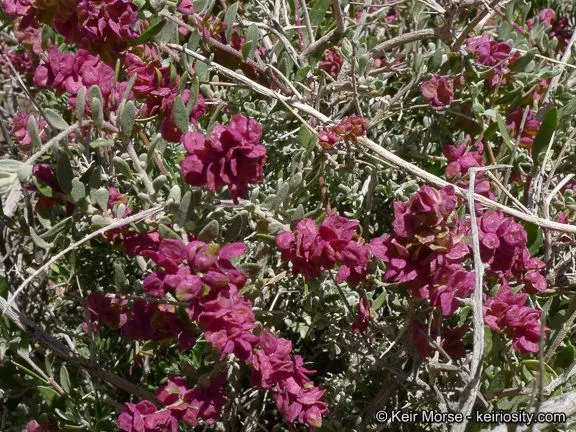
Author: (Hook.) Moq.
Bibliography: A.P.de Candolle, Prodr. 13(2): 119 (1849)
Year: 1849
Status: accepted
Rank: species
Genus: Grayia
Vegetable: False
Observations: W. U.S.A. to New Mexico
Spiny hopsage, known scientifically as Grayia spinosa, is a notable plant species indigenous to the western regions of the United States, extending to areas as far as New Mexico. This resilient shrub belongs to the Amaranthaceae family, a diverse family known for its multitude of species that thrive in various challenging environments.
Grayia spinosa was first described by the eminent botanist A.P. de Candolle in 1849, appearing in his work “Prodromus Systematis Naturalis Regni Vegetabilis” (Prodr. 13(2): 119). The formal botanical name was subsequently refined and attributed to another distinguished botanist, Horace Bénédict Alfred Moquin-Tandon, commonly abbreviated as Moq.
Spiny hopsage is well-adapted to the arid, rocky terrains of western America, visibly marking its presence in the challenging landscapes where other vegetation may struggle to survive. Its adaptation to these regions is not only a testament to its hardiness but also to its ecological significance in these habitats. The plant’s characteristic spiny structure provides it with a distinctive appearance and protection, allowing it to conserve water and fend off herbivores in climates where resources are scarce.
This shrub forms an integral part of the native flora, often contributing to the stability of the local ecosystem. Its ability to thrive under harsh conditions makes it a subject of interest not only to botanists but also to ecologists studying plant resilience and adaptation. The spiny hopsage exemplifies the remarkable ingenuity of nature in the face of adversity, and its study continues to offer insights into plant survival strategies in some of the most inhospitable environments in North America.
Eng: spiny hopsage
En: Spiny hopsage
© copyright of the Board of Trustees of the Royal Botanic Gardens, Kew.
Taken Oct 16, 1998 by EOL − Charles Webber (cc-by-nc-sa)
Taken Jun 26, 2010 by EOL − Steve Matson (cc-by-nc)
Taken Jun 26, 2010 by EOL − Steve Matson (cc-by-nc)
Taken Apr 10, 2015 by EOL − Steve Matson (cc-by-nc)
Taken Apr 10, 2015 by EOL − Steve Matson (cc-by-nc)
Taken Apr 18, 2022 by Ethan Greer (cc-by-sa)
Taken Jun 26, 2010 by EOL − Steve Matson (cc-by-nc)
Taken Jun 26, 2010 by EOL − Steve Matson (cc-by-nc)
Taken May 11, 2008 by EOL − Steve Matson (cc-by-nc)
Taken Jun 26, 2010 by EOL − Steve Matson (cc-by-nc)
Taken Jun 26, 2010 by EOL − Steve Matson (cc-by-nc)
Taken Apr 10, 2015 by EOL − Steve Matson (cc-by-nc)
Taken Dec 26, 2015 by EOL − Keir Morse (cc-by-nc-sa)
Taken Dec 26, 2015 by EOL − Keir Morse (cc-by-nc-sa)
Taken Dec 26, 2015 by EOL − Keir Morse (cc-by-nc-sa)
Taken Dec 26, 2015 by EOL − Keir Morse (cc-by-nc-sa)
Taken Dec 26, 2015 by EOL − Keir Morse (cc-by-nc-sa)
Taken Dec 26, 2015 by EOL − Keir Morse (cc-by-nc-sa)
Taken Dec 26, 2015 by EOL − Keir Morse (cc-by-nc-sa)
Taken Dec 26, 2015 by EOL − Keir Morse (cc-by-nc-sa)
Taken Dec 26, 2015 by EOL − Keir Morse (cc-by-nc-sa)
Growth form>: Multiple Stem
Growth habit>: Subshrub, Shrub
Growth rate>: Slow
Ph maximum: 9.0
Ph minimum: 6.5
Family: Myrtaceae Author: (F.Muell.) K.D.Hill & L.A.S.Johnson Bibliography: Telopea 6: 402 (1995) Year: 1995 Status:…
Family: Rubiaceae Author: Pierre ex A.Froehner Bibliography: Notizbl. Bot. Gart. Berlin-Dahlem 1: 237 (1897) Year:…
Family: Sapindaceae Author: Koidz. Bibliography: J. Coll. Sci. Imp. Univ. Tokyo 32(1): 38 (1911) Year:…
Family: Asteraceae Author: A.Gray Bibliography: Pacif. Railr. Rep.: 107 (1857) Year: 1857 Status: accepted Rank:…
Family: Fabaceae Author: Medik. Bibliography: Vorles. Churpfälz. Phys.-Ökon. Ges. 2: 398 (1787) Year: 1787 Status:…
Family: Aspleniaceae Author: (Cav.) Alston Bibliography: Bull. Misc. Inform. Kew 1932: 309 (1932) Year: 1932…